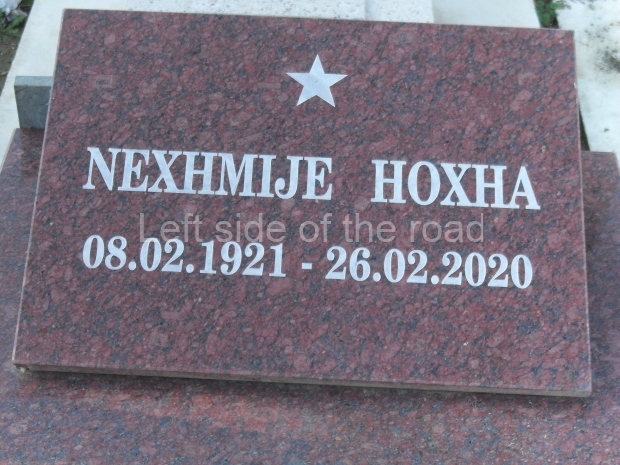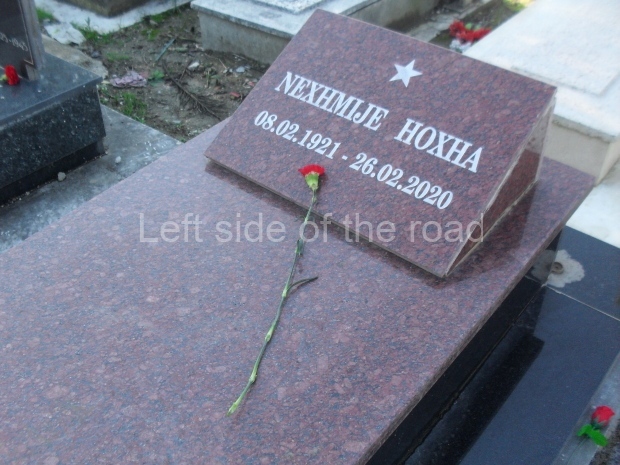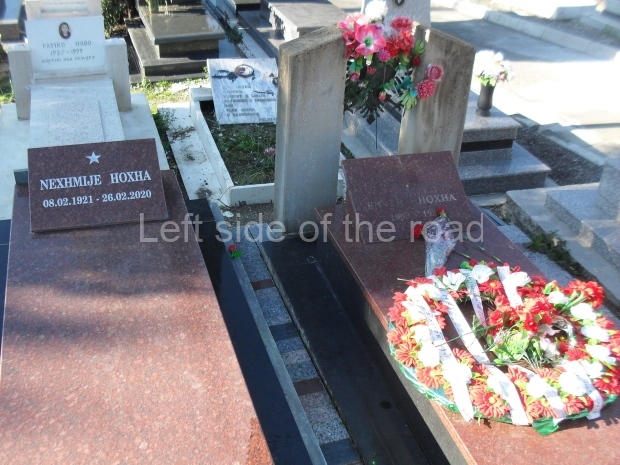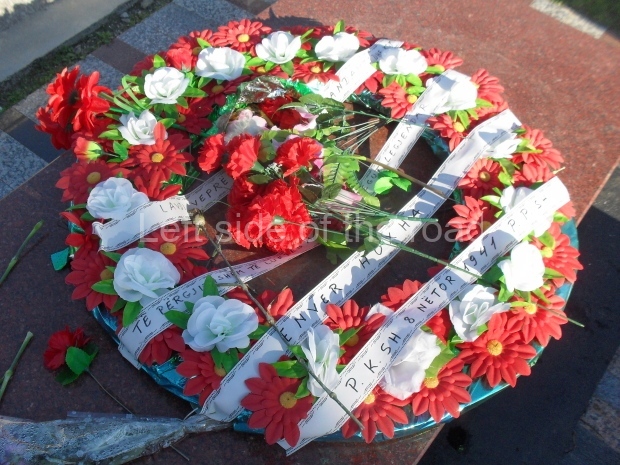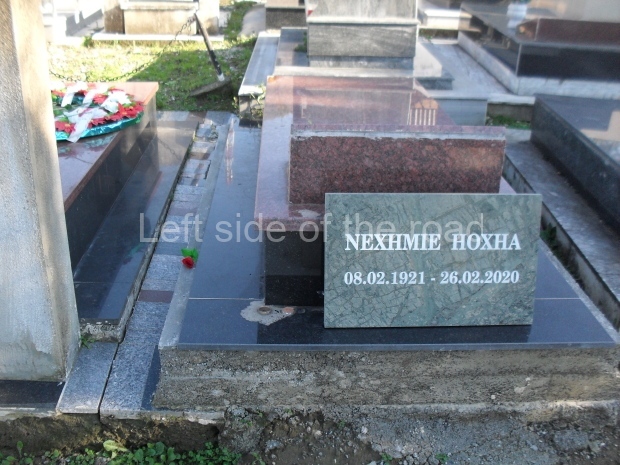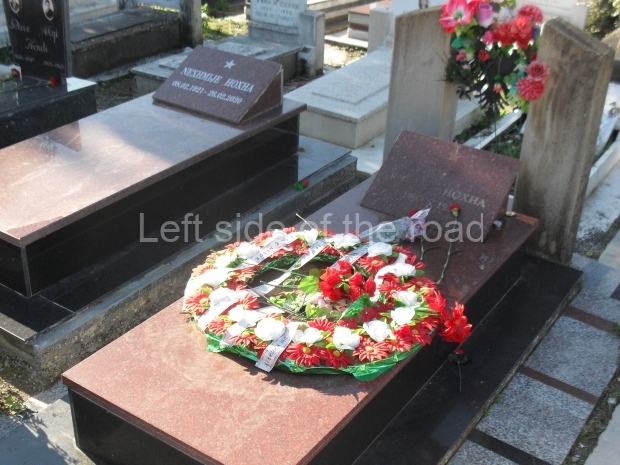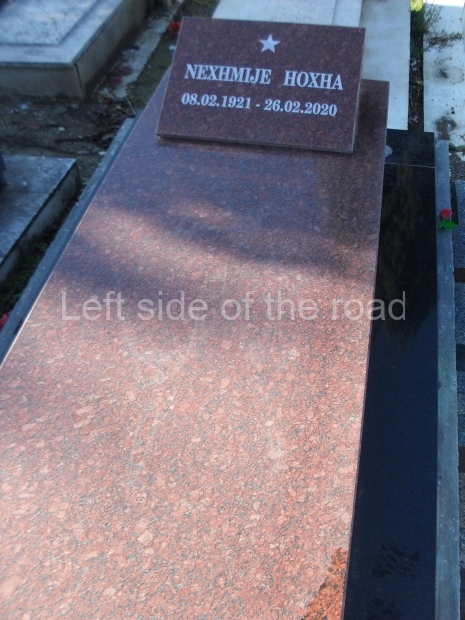
Tepelene Historical Museum Facade
More on Albania …..
View of the world
Ukraine – what you’re not told
Tepelene Historical Museum
Most towns of any size (and a number of smaller villages) during Albania’s Socialist period would have had a small museum telling the story of the Anti-Fascist National Liberation War. Often, though not always, these could be found as part of the Martyrs’ Cemetery but at other times they would be closer to the town centre. The Tepelene Historical Museum is one of those which stands alone.
Sadly many of those attached to the Martyrs’ Cemeteries are normally empty and sometimes abandoned and filthy. This is very much dependent upon the local people and municipality. For example, the museum at the Martyrs’ Cemetery in Lushnjë is virtually empty but the building and grounds are kept clean and tidy. On the other hand the museum attached to the cemetery in Krujë was the home to a decomposing dog when I visited some years ago.
Some museums have been censored. Many references to the struggle of the Partisans have been removed from view in Ersekë and the exhibits of the past just piled on top of each other in a closed room on the first floor (although you may be able to get a look in if you ask). And that’s despite the fact that the facade of the Ersekë Museum is an amazing, and huge, bas relief celebrating the achievements of the Partisans and which is in very good condition. That would seem to indicate that the local people have some respect for the past and are proud to be the home of a unique work of art.
The museum in Bajram Curri was looted in the 1990s and the mural defaced – although the lapidar outside was undamaged. Others have been converted to other uses. What used to be the museum in Proger is now the villages medical centre – although I’m sure there would have been a medical centre during the Socialist period so don’t understand why it was moved.
But back to Tepelene. And this is one of those that has fared better over the years. There has been some investment in making repairs and keeping everything clean and suitable for visitors. (Unfortunately this is not always the case, Gjirokaster Castle Museum being a case in point which has the feel of neglect wherever you are in the complex.)
The first thing to notice is the facade. The marble facing has been cleaned up in recent years and original wording, in large red letters, of ‘Muzeu Historik’ has been replaced with just the word ‘Muzeu’ – but in larger, red letters.
However, the most important aspect of the facade is the symbol on the right hand side. Attached to the the building is a large (it must be at least 2 metres high), bronze sculpture of a Pickaxe and Rifle representing the slogan of the Party of Labour of Albania – ‘To build socialism holding a pickaxe in one hand and a rifle in the other’. (You can get more information of the meaning of this symbol as well as an introduction to the construction of Socialism in Albania in the book ‘Pickaxe and Rifle’ by William Ash.)
This is quite possibly unique. Having visited many of the museums in the country I haven’t seen its like so I was happily surprised when I first saw it and even more pleased that it now stands out clearly since the marble has been cleaned of years of staining.
Through the main door you are faced with the museum office and that’s where you pay. If you wish the guardian will give you a guided tour but you can also take things at your own pace if you wish. We are not talking about a huge space, the museum being on two floors, consisting of little more than six or seven rooms.
The first room on the ground floor has artefacts from the very early days of Albania and the development of Tepelene as a town up to the beginning of the 20th century and the fight for Independence from the Ottoman’s.
However, of main interest to me (and anyone else who has an interest in Albanian lapidars or Socialist Realist Art in general) is the large maquette, in white plaster, that stands at the far side of the room, next to the entrance to the second room.

Maquette Tepelene Martyrs’ Cemetery lapidar
This is a representation of what was planned for the lapidar at the Tepelene Martyrs’ Cemetery which is located in the hill immediately above the museum. (You can see the top of the lapidar if you are in the Ali Pasha Square facing the museum. Look up and slightly towards the south and you will see it through the trees.) Why it was never completed as in the maquette I’ve not been able to ascertain nor do I know who was the sculptor commissioned to produce the work. What exists in the cemetery is the large column and the representation of the red flag at the top with a large star on the left, at ground level. But the figures and the slogans were never completed. What exists has always looked top heavy to me but after seeing the maquette I realised that it fits in with the original design. When it was decided not to go with the full sculpture it would have been better if a new design, less ambitious, had been chosen.
This could be that it was one of the later lapidars (of the 1980s) and following the death of Enver Hoxha in 1984 was a victim of the change in policy of the Ramiz Alia government towards the Albanian Cultural Revolution. Artistically this is unfortunate. If it had been completed as proposed then it would have been one of the most impressive of the larger lapidars.
The next, small, room contains a memorial board of those from the Tepelene area who die in the struggle for Independence both pre-1939 (the struggle against the Ottomans) and from 1939 in the Anti-Fascist National Liberation War against the invading Italian and Germans. Opposite are the busts of three ‘People’s Heroes’, those who had been picked out for their exceptional heroism in the fight against the fascists. (Tepelene also has a number of these busts displayed in the town, in the square close to the Bashkia (local municipality).

Tepelene town
The next room is mainly devoted to the independence struggles of the 19th into the 20th centuries. However, immediately on the right – above a table on which there are various WWII machine guns – is a painting by Ar Loli.

Ar Loli
I don’t know the title and the date is difficult to read. It depicts a Partisan ambush on, probably, a Nazi column in the mountains. The Partisans have both the political and the physical high-ground and all the fighters are firing downwards, into a valley or dip in the land. These are Communists – as stated by their red scarves and the red stars on some of the caps. In the centre a Partisan fighter keeps on firing even though he has sustained a head wound – as does another in the background. On the left of the picture is a bugler who is facing away from the conflict but is in the act of calling others to the fight. This is a common motif in such paintings and sculptures, as can be seen, for example, on the magnificent Arch of Drashovice.
Above the bugler is a Partisan in traditional countryside dress and he is the standard bearer. The flag is the red flag with the black double headed eagle. When depicted with a group that are fighting in the 1940s this banner would have a red star above the eagles heads but I can’t make one out here. Whether it ever existed or whether it has been painted out (which is not uncommon in a number of locations – most notably on the mosaic on the facade of the Historical Museum in Tirana) I would not know. (Records of all these paintings/art works must exist but the most readily accessible source was the Writers’ Union archive which was destroyed by vandals in the 1990s. Whether the National Archives have this information I have yet to discover.)
Sheer mountain cliffs, indicating the impressive and incredibly difficult landscape in which most of the fighting of the Partisan took place, are also common motif in these paintings, as are the flames coming from the vehicles of the armoured column that dared to enter the territory. Surprisingly missing from this paintings is any female Partisan – women having played a major role in the liberation of their country from the Nazis.
The four other paintings in this room are from battles with the Ottomans before Independence on 28th November 1912. All of them include the idea that the Albanians fought from high ground, territory they knew well and could use to their advantage. They are either firing downwards or looking to see if there are other enemy in the vicinity.

Against the Ottomans
One of them, depicting a scene where there has been hand to hand fighting, is a little bit more gruesome than most. The central Albanian is sheathing his bloodied sword, standing over his victim who is bleeding out into Albanian soil. To his left another Turkish invader is about to meet his end by having his brains dashed out by a huge rock. His terrified face can be seen between the legs of his assailant. In this picture it’s the traditional dress that separate the Albanians from the Turks.

Attack from on high
Another picture is of a slightly later conflict against the Ottomans as the swords and rocks have been replaced by early firearms – and there’s a small cannon in the bottom right hand corner. This one is by M Congi and is dated 1979. Again no title. However, we have the same idea of the Albanians using the terrain, the high and difficult mountains, to their advantage against any invader.

Meeting in the countryside
The next one I find slightly confusing – lack of information tickets doesn’t help. This one is of a meeting in the countryside and all but one of the people in the picture are wearing traditional costume and virtually all the men wearing the conical felt hat, the qeleshe. Towards the right hand side of the painting a man stands reading from a large piece of paper, presumably a declaration of sorts. A group of men in the foreground are armed with what look like 20th century weapons. Facing the man making the declaration is another man, bare-headed, holding a large axe in both his hands and on his back he has a fur cloak. To the right of him is the only woman discernible in the panting.
In the background is a range of mountains which are likely to be those close to Tepelene. The scene seems to be set quite high up as there is a rushing stream on the left hand side, at the head of which stands a large tree.
Now comes the two elements that present confusion rather than clarification. Immediately behind the declaration maker is a man, facing out of the picture, who is wearing a blue suit and a red tie. He’s obviously not a local but someone from the city and his style of dress indicates second half of the 20th century. Behind his head is a red flag with the twin headed, black eagle – but I can’t make out if there is a gold star between the heads of the bird – as that would help to date the event.
Is it a post-Liberation picture where the declaration is about the land being officially given to all the people of the village having dispossessed the previous landowner? But if that is the case why is the picture being displayed in the room which tells the story of pre-1939 independence struggles? At present I’m stuck on this one.

That’s where we attack
The final picture in this room is of a group of armed men who are standing on a hill along the coast. This, therefore, has no direct connection to Tepelene as it is some kilometres from the sea. In the background are the hills of an island some distance away and the only place that could be would be the Greek island of Corfu, which is just across the straights from the Albanian town of Saranda. (It was in this general area that the so-called ‘Corfu Channel Incident’ took place in 1946. This was when the British Labour Government tried to intimidate the young Albanian Socialist government by sending a flotilla of warships into Albanian territorial waters.)
Again there are few clues in this picture of what the event is supposed to be. The principle figure in the foreground holds a rifle in his left hand as he points to some unknown location with his outstretched right arm. All the other figures in the picture, bar one, are looking in that direction. The one is also slightly out of place as most of the figures have traditional dress and the qeleshe but he is bear-headed and seems to be wearing city clothing. He also has a beard, as opposed to just the moustache worn by virtually everyone else, and has a bemused, confused look on his face. Although there’s a red flag prominent in the picture again there are no clues here to the exact date. As in another of the paintings in this room there is an uncharacteristic absence of any female figure.
Passing through the doorway to the left of this room you enter the room with artefacts, photographs and information about the Anti-Fascist National Liberation War fought by the Albanians Partisans against first the Italian fascist and then the German Nazi invaders.
When it comes to Socialist Realist paintings this room includes three examples.
The first two are high up on the left hand wall as you enter the room.

Three Communists
The first is a half body portrait of three Communists, two male and one female. The man in the foreground is obviously the officer. (Although there is, normally, a good representation of women in such paintings I must admit that I can’t think of many where it is obviously the woman who is the most ‘senior’ in the story.) He is holding a pair of binoculars in his right hand and in his left hand he holds his crumpled up cap (with the red star showing). He wears a red scarf, indicating he’s a Communist and also has a revolver rather than a rifle. In this manner the Albanian Partisan ranking system followed what was ‘traditional’ in all the armies of the time.
To the officer’s left stands a young woman. Her abundant black hair spills out from underneath her cap, which also has a red star at the front. Around her neck she also wears a red scarf and in her right hand she holds her rifle by the lower end of the barrel. Around her waist she has ammunition pouches attached to the belt and hanging from it is a mills bomb (grenade). There’s a red banner (with the black eagle) between the officer and the female.
Behind the right shoulder of the officer we see the head of a young, male Partisan. He has his rifle slung over his right shoulder so we only see the very top of the barrel.
All three are looking in the same direction.
By looking to the far right of the painting we see a long line of diminishing figures walking along a narrow mountain path so our three figures are at the head of a Partisan column on the march.

Kodheli 1970
The painting next to the three communists is one of a Partisan officer explaining something to an old shepherd. We see him in a partial profile and we know he’s a shepherd by his crook, which he holds with his right hand close to his face. On his back is a rucksack and his black sheepskin coat has fallen down to his waist.
The main figure in this painting is a Partisan officer. He has the lot. In full uniform; a cap with a red star on the front; a dispatch case resting on his right hip; a belt for his revolver which has ammunition pouches attached; a rifle the butt of which is resting on the ground and which he is holding upright with his left hand; and on his lap rests a light coloured raincoat.
He’s sitting on a wooden packing case and his right arm is extended towards the viewer with his finger pointing at us. He seems to be explaining something rather than asking questions. His whole manner is such that he knows what he is doing and he just wants to pass that information on to the old man.
This idea is reinforced by the manner of the two other figures in the painting which are a teenage boy and a young man who are to the left and behind the officer. They appear intent on understanding what is said, the young man having a slightly questioning look on his face.
This painting is signed Khodheli and is dated 1970. The four figures fill the picture so it’s impossible to know the location other than it is in the countryside.

The Liberation of Tepelene
The next painting is the large one at the other end of the room which depicts the liberation of Tepelene in September 1944. It bears a lot in common with the mosaic in the Martyrs’ Cemetery in Durrës and also the bas relief in Bajram Curri.
There are similarities but there are also some quaint differences which make it not just a copy of the same idea. All these images are idealised representations of what actually happened, the actual liberation more than likely having been a very confused and chaotic event.
What we have here is a Partisan column marching into the town, the grey structure dominating the background on the right being the castle around which the town grew – and the battle scars on the battlements indicate the ferocity of the battle. The Albanian flag flies above the castle, replacing the swastika that would have been there beforehand.
The front row of the column comprises three partisans, two men and a woman, all in uniform but not exactly the same as Partisan armies don’t have a distant supply chain to provide exact uniformity of dress. The three of them are Communists – by the red scarves two of them are wearing and the red star on the caps of all three.
They are marching in step so this isn’t just an unorganised event. The woman has her mouth open as if she is singing (as is another woman whose head we can see just behind the left shoulder of the central male officer). There are other indications that this was a celebration that would have included music as on the right hand side you can see a group of men dancing, handkerchiefs waving above their heads and although they are not in this image that would have meant there were musicians in the vicinity.
In both the Partisan column and the welcoming crowd there is a mix of those from the countryside and those who were more comfortable in the towns. The moustaches and traditional caps on some of the men picking them out as from the smaller villages, the clothes of working men those from the towns.
The Partisan marching just behind the lead woman has a white bandage poking out from under his cap indicating that the battle might have been won but not without sacrifice in killed and wounded – and later a Martyr’s Cemetery would be built on the hill to the south above the town.
There are a couple of images of people greeting each other further into the painting. On the left, just behind the wounded marching Partisan an older woman is talking to, and seems to be holding the arm of a young male Partisan. This could well be a mother who had lost her son or daughter in the liberation struggle. Many gave the ultimate sacrifice in the battle against fascism and many of them were young people, some not even out of their teens. This can be seen by the dates on the tombs in such places as the Gjirokaster Martyr’s Cemetery and in the example of young Liri Gero from Fier.
On the left, just to the left of the older man with a white moustache with a rifle slung on his back, standing and watching the column go by are two comrades embracing. Both of them have the uniform of the Partisans but one has a bandaged head so it indicates that they were separated when one of then was wounded and this is the first time they have got back together.
There are four children in the painting, all of them together on the right hand side of the foreground. The youngest is being held in the arms of his mother and he has his right arm outstretched towards the partisans with his finger pointing at them. Another, older, boy (in a red shirt) is holding the hand of the male Partisan who is marching in the front row on the right. The Partisan grips the young boy’s hand tightly and there is a connection between them as they have eye contact, with the boy smiling. The Partisan is either singing or saying something to the boy.
Next we have two young girls. The one in the orange dress is smiling and applauding the column. Her companion who is slightly younger is on the very edge of the painting. She is dressed in a blue blouse and a white skirt and seems to have her right hand on the shoulder of her older friend/sibling. What’s important to notice about these children is that all but the very last girl are not wearing shoes – an indication of the poverty that existed in the country even before the invasion by the fascists in 1939. The war didn’t created the poverty, it only made it worse.
The final thing to notice is the four spent shell cases that are lying on the ground at the very bottom right hand edge of the painting.
The displays on the walls in this room give an idea of who fought in the area and some details of the military campaign. There’s also a number of pictures of the various partisan sections posing for group photos. You’ll come across such photos in many of the still existing museums in the country. This is very similar to revolutionary movements in Latin America where having their picture taken seemed to be part of the job of being a Partisan or fighter. I have never really understood this practice, especially when you were faced with an enemy such as the Nazis who would use any such captured material to undermine and destroy the Partisan opposition and base within the community.

Tepelene Historical Museum – Nazi murder
One photo to look out for is one which is on a board on the wall to the left as you come in the room. This shows two Partisans hanging from a low tree (so they were straggled to death rather than being hung) with a group of German soldiers posing with their ‘trophies’. This was common practice wherever the Nazis invaded and there were many such examples in Albania. One of the most notorious being the public execution of the two young partisan women (Bule Naipi and Persefoni Kokedhima) in Gjirokaster on 17th July 1944. And still one of the reactionary governments post-1990 decided to allow the construction of a Fascist memorial, in Tirana Park, to those Germans who died in the failed invasion of the country.
The final room on the ground floor is a very small one that was closed to the public on my first visit. This consists of a number of hand made boards which have photographs of the achievements of Socialism in Tepelene in the years 1945 to 1990. These cover all aspects of life from industry and agriculture, to education and culture, housing and social care. This is quite a unique exhibition as this must have been one of the last such photographic exhibitions opened to the public before everything fell apart later that year.
There’s also a painting of Enver Hoxha on a visit to the town. This is discussed in depth on the post Enver Hoxha returns to Tepelene. Underneath the painting, on the shelf, are the collected written works of Comrade Enver in almost 50 volumes.
The first floor, where there is a small ethnographic exhibition (clothing and items of everyday use in the Tepelene region) is accessed via the stairs that are in the first room – close to the entrance/exit.
The doorway off to the left, at the top of the stairs, leads to a small library/archive room. This is the area that overhangs the main entrance and the wall on which is attached the Pickaxe and Rifle emblem. Everything in the archive is in Albanian but at least it’s an archive that still exists and could be useful for researchers in the future who have topics to study in the local area.

Partisan Meeting
On the way to that room you pass a very large painting – unfortunately not in the best of condition. This is by S Milori and is dated 1969. Again, without a title it’s difficult to know exactly what it depicts.
We have a meeting in the countryside and the central figure is making a point, giving a speech to the assembled group of villagers, armed Partisans and a couple of town dressed men (in suits and ties, one wearing a town hat, one holding his in front of him) who seem to be the object of his discourse as he is pointing an accusing finger at them with his right hand. In his left he has some papers, whether his notes to remind of what to say, or some official document that has caused him to be there.
The speaker is a Communist Partisan as he wears a red star on his cap. The two that seem to be the subject of the meeting stand somewhat sheepishly, both of them with their hands grasped together in front of them. Are these collaborators who have been discovered by the local people? Are they speculators who have been profiting at the expense of the local people? Is this a People’s Court?
Some of the crowd are looking at the speaker, some are looking at the men he is singling out. One woman is looking at us. Two old men, sitting on rocks in the foreground, seem to be discussing the merits of the argument.
This is the problem with so many paintings in present day Albania. Information that would have been readily available prior to 1990 has been lost over time so speculation on what the events depict is all that is left to the viewer. Perhaps one day the missing information can be, once again, associated with the art works and thereby allowing for a more accurate interpretation.
Location:
At the southern end of Rruga Ali Pasha Tepelena. The museum is just off the square that meets the main road coming from Fier/Vlora on the way to Gjirokaster. This square is south of the main town and is where all the buses going either north or south stop to drop off or pick up passengers. You can’t really miss the square when you’re there as it has an ugly statue of a lounging Ali Pasha, an 18th/19th century aristocrat opposed to the Ottoman Empire, who was responsible for the building of the castle in Tepelene. Once Socialist heroes were denigrated the Albanians had to look for some nationalist leaders to fill the gap. Hence the relatively new statue in the square. The museum is up some steps. towards the west of the statue.
Entrance: 100 lek
Opening times: 10.00 – 19.00, Monday to Friday (but closed between 14.00 and 17.00)
More on Albania …..
View of the world
Ukraine – what you’re not told


